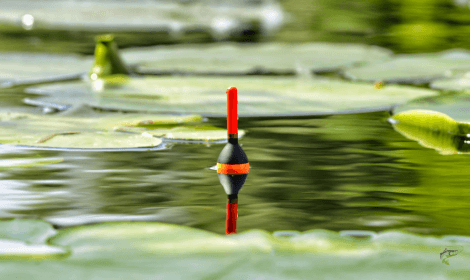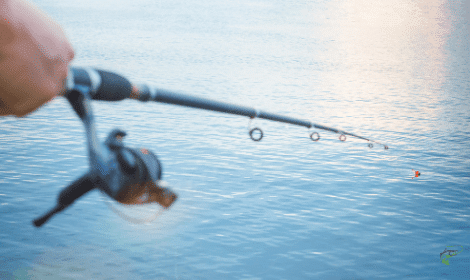
Float fishing for carp can provide one of the most fun methods for catching these fish. Float fishing is also great for beginners, as it has many similarities to the beginner style of fishing featuring floats or bobbers to detect a fish on your line.
But, float fishing is a viable tactic for even the seasoned carp angler. In this article we are going to dive into the art of float fishing and give you some insight on popular rigging methods and tactics.
What Is Float Fishing?
Float fishing is very similar to the standard bobber fishing that most people have done at least once in their lives, making it a great entry into the carp fishing world.
Though there are differences in certain aspects such as float type, rigging, and bait considerations. Anglers use a float like a bobber, to detect a bite, or fish picking up the bait.
Some floats lay on their side until the fish pulls it upright, and others work just like a standard bobber setup.
Gear Requirements

The great thing about float fishing is that for beginners it’s very affordable, without the need for the plethora of gear and tackle needed for other methods of carp fishing.
You can find a suitable rod for carp fishing at relatively low prices, and it doesn’t need to be anything top end or fancy, unless of course you want to spend more.
We recommend a through action rod that is anywhere from 10 to 12 feet in length for good float and line control. The longer the rod, the quicker you can pick up the slack line to set the hook, resulting in less lost fish and allowing you to connect more, especially when it comes to river fishing situations.
When it comes to hooks, we would recommend a size 10 hook. While you can go smaller in hook size if desired, we prefer size 10 to help weed out small species of fish that you probably don’t intend to catch.
This will help us stay more productive on the water, having less hassle or wasted time baiting hooks constantly. Various sizes of split shot sinkers are also a must have.
Floats are obviously needed and there are a wide variety of float styles on the market, from wagglers, sticks, poles, and sliders. These floats are tailored to different types of fishing conditions, let’s break down when to use these floats
| Type of Float |
Ideal Usage |
| Wagglers | Still waters like lakes, ponds, and canals |
| Sticks | Places with a current such as rivers |
| Pole | Vary from shallow water, to all around waters, with body up shapes for current |
| Sliders | For large bait presentations or windy conditions |
Last but not least is line and reel considerations. We recommend a monofilament line for all round float fishing for carp.
Reels do not need to be fancy either, unless you want something high cost and high quality, with medium-sized reels being well suited for the task.
Lakes, Rivers, and Ponds
When it comes to the type of water you are fishing, there are different tactics you can employ that will help you be more successful in catching carp. Let’s take a look at what you should do for rigging and what tactics you should employ on these various bodies of water.
Rivers
The main challenge when float fishing on a river is dealing with the current. Due to the current we have to make some tackle choices to help our cause and allow us to effectively fish.
If you’re spodding or pre-baiting an area on a river with current, throw upstream a bit forward of where your hooked bait location will sit.
The current will move your bait downstream as it sinks to the bottom. The distance you need to pre-bait upstream depends on the severity of the current, with faster current required more distance.
One good point to make on fishing rivers, is that your baits scent will flow downstream. Carp have an excellent sense of smell, and will travel upstream to seek out your bait.
Ponds and Lakes
Ponds and lakes are much more straightforward than rivers. Simply find a location that carp are frequenting such as runs, and get some bait out there
If you pre-bait, make sure to spod in a small area. If you aren’t familiar with spombing or spodding, check out the spombing article featured on this blog.
Depth is your biggest consideration when fishing lakes and ponds, be sure to know how deep the water is where your bait sits. This matters if you are trying to present your bait slightly off the bottom or suspended further up in the water column.
Get the Lead Out
Another important consideration when float fishing is to make sure you use the correct amount and type of split shot sinkers.
Most floats on the carp fishing market today have ratings that come with the package on how much weight you should use with the float, and at times they can call for pretty precise requirements.
With lettering calling out the size of shot and the number recommended. We are going to include a chart for the U.K. standard split shot conversion.
| SIZE | WEIGHT | EQUIVALENT |
| 3SSG | 4.8g | 6 x AAA |
| 2SSG | 3.2g | 4 x AAA |
| LG | 3g | |
| LSG | 2g | |
| SSG | 1.6g | 2 x AA |
| AAA | .8g | 2 x BB |
| AB | .6g | 2 x No1 |
| BB | .4g | 2 x No4 |
| No1 | .3g | 6 x AAA |
| No3 | .25g | 2 x No6 |
| No4 | .2g | 3 x No9 |
| No5 | .15g | 2 x No8 |
| No6 | .1g | 2 x No10 |
| No8 | .06g | 2 x No11 |
| No9 | .05g | |
| No10 | .04g | 2 x No12 |
| No11 | .03g | 3 x No13 |
| No12 | .02g | 2 x No13 |
| No13 | .01g |
It’s important to note that if you are fishing in deep water with multiple split shots covering a distance farther out from the shore, you should avoid using the split shot with the ears on them, while these are certainly the easiest to put on and remove, when the bait and line are flying through the air they can catch and tangle your line up, causing major issues.
Plumbing the depth

Take a lead weight and add it to the end of your line, no fancy knot tying required.
In fact, some weights have rubber on the end which you can put on your hook, making it incredibly easy. When casting in the desired area that you wish to fish, watch your float, and adjust according.
Laying on its side? You have slack between your sinker on the bottom and your line. Floats disappeared? Your setup is too short and you need more line between the hook and your float.
You get the point.
You can set this up very precisely so that you will see your float stand up or move with the slightest of bites, allowing you to know immediately that a fish has picked up your bait.
I’ve written a full length post on plumbing depths if you are looking for any more information.
Cast away
You’re now ready to fish, but we still have a few more tips for you to keep in mind. If you’re fishing around vegetation, it will be a good idea to check on your setup regularly to be sure no weeds or vegetation have fouled your bait presentation.
If you are intent on fishing in weeds then take a read at my post on fishing in weedy lakes to be catching fish from aquatic jungles in no time.
Sometimes you need to make multiple casts in a vegetated area to learn it, and you might find pockets in the vegetation of “alleys” these can really be your money spots in terms of catching fish.
If you leave your hook tied on the line for an extended period, be sure to cut your line and redo your knots, nothing is more frustrating than losing a fish to knot failure, is it just me or when a knot fails is it usually on a really good fish?
Conclusion
Float fishing for carp can be a very productive, relaxing, and easy way to catch carp. These essentials will get you started in your float fishing adventure.
There is also much to learn if you intend to float fish on a regular basis with many rigging options, floats and tactics, allowing for float fishing can be as easy or as complicated as you want to make it.
As mentioned earlier, be sure to choose a float that suits your conditions on a chosen body of water, as well as use the proper weighting sizes, amount and evenly spread placement to give your bait the most natural presentation possible.

